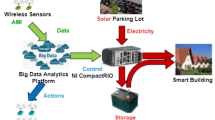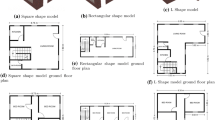Abstract
In recent years, the limited energy sources and their huge costs in many countries to save money have attracted the attention of many scholars. The purpose of the energy consumption assessment of a building is to reduce the waste of the energy, and this reduction in the energy has a direct relationship to the lower costs. In this paper, the researcher tends to investigate the sensitivity and the energy analysis of a warm and dry residential complex in Iran (Yazd). Initially, the simulation of the energy consumption of a building was calculated by using the eQUEST software, to determine the thermal load of the building for a range of important parameters (such as wall insulation, roof and floor insulation, air penetration, glass type and window size). Then by using the SPSS software, the relationships have been extracted to connect the energy of the building with these factors. Then, by using the SPSS software, it attempted to connect a meaningful relationship between the energy consumption of the building and the mentioned factors. Also, the energy efficiency of the building was optimized by converting the data to the neural network, by using the genetic algorithm. Finally, this study was also carried out in warm and dry areas, to describe the accuracy of the results, and in each step, appropriate validations have been done.













































Similar content being viewed by others
References
Adua L, Clark B, York R, Chen C-F (2019) Modernizing our way out or digging ourselves in? Reconsidering the impacts of efficiency innovations and affluence on residential energy consumption, 2005–2015. J Environ Manag 252:109659
Blázquez T, Ferrari S, Suárez R, Sendra JJ (2019) Adaptive approach-based assessment of a heritage residential complex in southern Spain for improving comfort and energy efficiency through passive strategies: a study based on a monitored flat. Energy 181:504–520
Camarasa C, Nägeli C, Ostermeyer Y, Klippel M, Botzler S (2019) Diffusion of energy efficiency technologies in European residential buildings: a bibliometric analysis. Energy Build 202:109339
Dehghani N, Zamanian S, Shafieezadeh A (2020) An active machine learning approach to reliability analysis of gas pipelines exposed to seismic hazards. In: UESI Pipelines 2020 Virtual Conference, Aug 2020
Dino IG, Meral M (2019) Impact of climate change on the existing residential building stock in Turkey: an analysis on energy use, greenhouse gas emissions and occupant comfort. Renew Energy 141:828–846
Ghasemi M (2015) Investigation of traditional dwellings in four Middle Eastern cities in terms of strategies for coping with climatic factors and privacy Master’s thesis. Eastern Mediterranean University (EMU)-Doğu Akdeniz Üniversitesi (DAÜ)
Hosseini M, Noradin Ghadimi F (2015) Wind energy uncertainties in multi-objective environmental/economic dispatch based on multi-objective evolutionary algorithm. J Res Sci Eng Technol 3(03):7–15. https://doi.org/10.24200/jrset.vol3iss03pp8-15
Miri EM (2016) Ecological building design: a proof of concept and identifying the factors which deter the use of Iranian vernacular principles in modern architecture. Doctoral dissertation. London South Bank University
Pourjafar MR (1995) The role of the environment in Persian Gulf architecture and urbanization. Congress of Urban History Architecture, Arge Bam Kerman, Iran
Sadoughi A, Kibert C, Mirmohammad F, Jafari S (2019) Thermal performance analysis of a traditional passive cooling system in Dezful, Iran. Tunn Undergr Space Technol 83:291–302
Sahebzadeh S, Heidari A, Kamelnia H, Baghbani A (2017) Sustainability features of Iran’s vernacular architecture: a comparative study between the architecture of hot–arid and hot–arid–windy regions. Sustainability 9(5):749
Saljoughinejad S, Sharifabad SR (2015) Classification of climatic strategies, used in Iranian vernacular residences based on spatial constituent elements. Build Environ 92:475–493
Shaeri J, Aflaki A, Yaghoubi M, Janalizadeh H (2018) Investigation of passive design strategies in a traditional urban neighborhood: a case study. Urban Climate 26:31–50
Soflaei F, Shokouhian M, Zhu W (2017) Socio-environmental sustainability in traditional courtyard houses of Iran and China. Renew Sustain Energy Rev 69:1147–1169
You Y, Kim S (2018) Revealing the mechanism of urban morphology affecting residential energy efficiency in Seoul, Korea. Sustain Cities Soc 43:176–190
Acknowledgement
We thank all participants in this research and Islamic Azad University, Science and Research Branch.
Author information
Authors and Affiliations
Corresponding author
Ethics declarations
Conflict of interests
The authors declare that there is no conflict of interests.
Additional information
Editorial responsibility: Samareh Mirkia.
Rights and permissions
About this article
Cite this article
Baheri, A., Najafi, M., Azimi, A. et al. Analyzing the sensitivity and energy efficiency of a residential complex in warm and dry climate of Iran: the case study Yazd Province. Int. J. Environ. Sci. Technol. 19, 43–72 (2022). https://doi.org/10.1007/s13762-020-02996-3
Received:
Revised:
Accepted:
Published:
Issue Date:
DOI: https://doi.org/10.1007/s13762-020-02996-3




